|
Nothing is so exciting as starting a young horse under saddle.
Finally, all the dreams of the breeder, owner and trainer are taking a massive step towards the end result of a happy, confident ridden horse. So much has been invested into these young horses up to this point. Think of the breeder pouring over bloodlines and stallion videos to select what they believe to be the very best match for their mare to produce what they were aiming for in their breeding program. Hours upon hours are spent with many researching everything possible about relatives and closely bred horses that may have been through auctions or performed. And then there is the actual cost of the semen, insemination and foaling down costs and correct nutrition, worming and foot care of the mare and the foal once it is born. The cost is huge! From weaning to starting under saddle obviously all the care costs continue in addition to the time spent handling these youngsters. They will be introduced to rugs, float/truck trained and do groundwork. Some will have been sent to professionals for this. Others will have done a lot of this with their owners who may have bought them as weanlings, yearlings or even older or may have bred them themselves. No matter who has done the work, a lot of time and money is invested at this stage and this is without any accidents or illnesses along the way. Then the horses are started under saddle, either by a professional or by the owner themselves. Around this time people are organising a saddle for the youngster. Many people don't want to send a new saddle to a professional starter with their horse and most professional starters only want to ride in their own saddles. This makes total sense as they need to know they can stay with the horse in balance no matter what happens underneath them. It would be impossible for them to do this in a saddle that may be too small for them or one that may either block them in or not give them enough support where they need it. At least initially and we totally understand that! The ideal situation is to have a fitter check any saddle you may be thinking of using on your youngster before you send the youngster away. Be sensible here and make sure you have worked with your horse so that he/she is relaxed with you placing the saddle on his/her back. You don't need to girth it up at this stage and unless you are experienced with starting horses it is not a great idea for you to be the first to do this. It is just important for the safety of your fitter and so they can assess it properly that your horse stands quietly and is not nervous. Although this will only be a rough check as no saddle can be deemed perfect unless girthed up and assessed with the horse being ridden, it is still very much worth doing. Your fitter will be able to check the width, length and shape of the tree and panels. If any of these are wrong your young horse is being set up to feel pain and discomfort when asked to go forward, bend or canter and you are setting them up for terrible habits to form. Ideally organise your fitter to check the saddle again (or bring out new ones for you to try if you don't have one that looks suitable) the last week your horse is at the starters or if that is not possible then as soon as he/she is home. Some youngsters can be very sensitive to a new feeling on their back so if they have only been ridden in a stock saddle and you go and put on your new dressage saddle they may react. It could be good to have them do this with the professional rider on them, even though as I said before the saddle may not be what they prefer. Most will understand and offer to do this in the handover of the horse. Remember that your horse will change shape dramatically in the time they are at the trainers so a saddle that may have looked good before they left could well do with some tweaking at this point in time. So what saddles are great for youngsters? Any saddle that fits! Hopefully gone are the riders who say "the horse has to earn their own saddle"! The horse's first saddle is possibly the most important saddle they will ever have as if not correctly fitting will set them up for a range of resistances under saddle. We also know that through main and discomfort horses change their way of moving and their posture, both of which set them up for early degenerative disease and a shortened saddle career. Don't be daft! Don't try to save money at this point when you think about what has been invested up until this point with these youngsters and the cost of trying to correct issues when they develop. Young horses are going to develop and change, and how much depends on the breed, workload and age. For most people it is sensible to use a saddle with changeable gullets if the horse is under 5 years of age such as the Discovery saddles. This way the gullet may be changed at any time and over a large range of sizes. They also have generous panels and gussets to allow a lot of adjustments to be made through the flocking by your saddle fitter. After 5-6 years of age, depending on breed and development, many riders choose a custom-made saddle such as a Ryder or Fiona Cork Saddle. These saddles can be pressed in or out 1 size either way but your saddle fitter, 3-4 times throughout the saddle's life, which along with their wool-flocked panels, allows for great adjustability. So good luck with starting your youngster! May it go smoothly and all your dreams come true! Above all have fun and enjoy the journey!!!
0 Comments
At the VH Saddlery WA Pony Club State Dressage Championships last year I met many absolutely gorgeous young riders, one of whom was Hannah who along with her family attended many of the talks I presented over the weekend. I came to learn that Hannah was struggling to find a saddle that suited both her and her pony, due to the length of her leg and his saddle platform area. When they finished competing for the weekend I sat quite a few saddles on her pony to see which trees would work best for him and which saddles would give Hannah enough room without extending too far back on her pony's back. In the end we decided the Fiona Cork saddles would be the way to go and the next step was to organise their saddlefitter, Brad Travers to measure her pony. 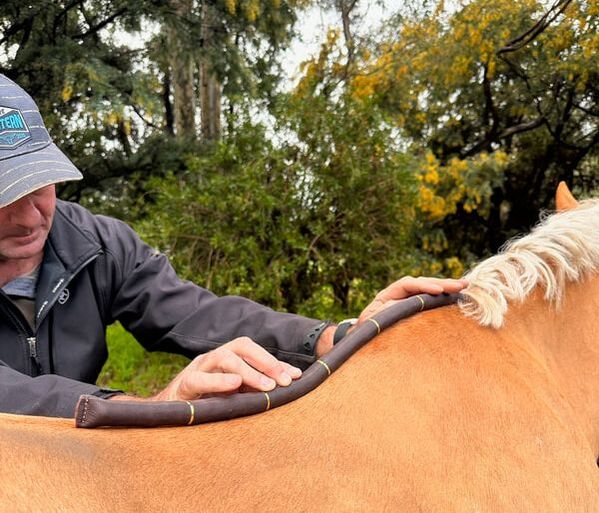 This photo shows Brad taking some measurements of Hannah's pony. He uses a special flexi-ruler which he molds to the pony's back and then carefully lifts it off and traces the shape onto specially marked paper. At the time the photo was taken Brad was taking the profile of the pony's spine. This helps the saddle makers know how flat or curvey to make the tree. Brad also templates across the back at each of the points marked on the flexirule. These measurements indicate how wide to make the tree and the angle and length of the rails of the tree. The measurements are taken several times, often reminding the horse to engage its core if it is one of those horses that stands in a totally different posture to when it is ridden. Several specific photos are also taken of the pony as well as the rider and sometimes even some video footage. The more information we can gather the better so that everyone involved in designing and making the saddle knows as much as possible about the horse and rider combination. I work with the rider to ensure the saddle is perfect for them in the way of their position. There are so many options available that riders would not even have thought about to ensure their legs hang correctly, in the right angles and without tension. Some options are obvious such as knee roll height, length, position and angle, seat width, depth and length and changes to flap lengths. Other options such as changes to stirrup bar placement and twist width are required less often but are so profound when made for the right reasons. 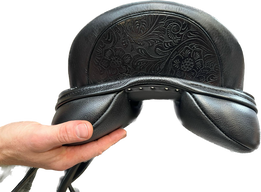 Once all the measuring is finished, the fun part begins! Riders get to choose the leather types and colours for all the different parts of the saddle as well as any bling they may wish to add. Fiona Cork is great and sends through photos at each stage, including samples of the leather when they are cutting out fancy prints and embossed leather. She is so particular about absolutely everything that it is an absolute delight working with her. Some riders go crazy at this point and sometimes I have to remind them what is and isn't allowed in their particular discipline! Hannah wasn't like that at all and chose a particularly classy floral print for the infill on the cantle on her new saddle. I think we went through five different prints with Fiona's help before deciding on this one and it was absolutely worth the effort! 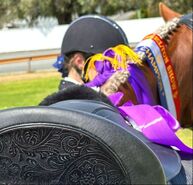 Most Fiona Cork Saddles "fit like a glove" from the day they arrive but like with any wool flocked saddles they need to be checked by your saddle fitter after 20 hours of riding, or earlier if they need to be balanced. After 20 hours the wool packs down and the fitters can tweak it to ensure the perfect fit. Hannah says "I am extremely satisfied with our custom-made Fiona Cork saddle which we ordered through VH Saddlery and was fitted by BT saddlefit. It is a surprisingly low cost for a high-quality custom-made saddle fitted to both horse and rider. It allows my horse to move more freely, is very comfortable and looks exquisite. I have had many comments about the beautiful inlay patterns.
I highly recommend VH Saddlery if you are looking for a custom-made saddle for comfort, fit, quality and value for money." We absolutely loved working with Hannah and her family and wish them all the very best with their equestrian pursuits in the future! My family have been breeding Welsh Cobs for the last 20 years at Kings Town Welsh Cobs in WA. My sister and I breed, train, and compete our home bred Welsh Cobs in breed, dressage and jumping shows. We grew up breeding and riding Welsh Cobs from a very young age and have found them to be such a diverse breed for all disciplines and they really shine in the competition arena. We have had a lot of success in the competitive pony dressage arena with many state championship titles and receiving wonderful feedback on our ponies. One thing we have always struggled with through the years has been finding a saddle that works for the Cob shape as well as complimenting us as riders for that close contact feel. Welsh Cobs have such a broad strong back pony with generally a lot of power in their hindquarter and a forward girth groove that every saddle we tried over the years would either not sit in the right place, bounce quite a lot in the back or just not have the right tree/gullet/panels, especially as they became stronger in their work and moved up the levels. I searched high and low for many years trying everything that came along in the end I just had to find something that 75% worked for the pony not necessarily myself as a rider. As a consequence, I started researching saddles overseas and I contacted many riders who had competed Welsh Cobs to a high level of dressage to find out what they were riding in and what they loved about the saddles they were using. Finally, after many years of research and searching I came across Fiona Cork saddles. I was initially interested in them because they had such a classic design and I had seen so many Welsh ponies competing in them in various disciplines at low level and higher levels overseas. Interested but not brave enough to take the punt in bringing one downunder, lucky for me I found out that Victoria Hamilton had brought some into Western Australia. I quickly jumped at the opportunity to try them on my ponies and my saddle fitter and I were amazed! It was the first saddle that we had sat on my ponies that had just worked with no need to change anything at all. It was stable, especially on my round pony who has no wither who I had always had trouble with saddles slipping and sliding but not this one. The pony was so much more confident under my seat, there was no bouncing in the back of the saddle and no sliding forward due to the fact that there were so many girth point options. The ponies were finally happy and comfortable and the 1 Saddle fits both of my ponies and not only did it fit them I had such a close contact to the pony and the knee rolls on this Fiona Cork saddle are so soft and sit in the right spot not making me feel like I’m jammed in on constricted at all it was a definitely a winner for myself and the ponies. I highly recommend these saddles, there are so many varieties and I really feel Fiona Cork really understand the broad back and the type of ponies and what we need as riders. I’m very eager to kick start 2024 with my ponies and their new saddle! Horses may be built downhill or may travel downhill. To confuse matters, some that are built downhill won't move downhill, yet some that are not built downhill will! Whatever the situation it can be somewhat challenging for the riders, but this needs not be the case!!!
A lot depends if the downhillness (for want of a better word!) is due to conformation, age, pain or training. Sometimes it is due to a combination of these and it is important to understand how each can be helped in different ways and how the horse's back and way of travelling can be expected to change in the future. Any choice of a saddle ideally should be able to accommodate these changes so will need a certain amount of adjustability. Mature horses with no underlying issues that are built downhill are relatively easy to fit. Saddle stability and balance is of utmost importance in these cases and Discovery saddles excell in this regard. As these horses most likely won't change a lot they are also great candidates for the custom made saddles by Fiona Cork Saddlery and Ryder Saddles. Obviously young horses will change but so will other horses through correct training and management. For example, horses that have been sore in their feet will change a lot in their gullet width requirement. We see this a lot with horses that have either been mildly laminitic, or those that have had negative palmar angles corrected through trimming or the use of pads. For these horses we always recommend saddles with adjustable gullets such as the Discovery saddles, Wembley Pro and Max Benz One. These saddles also have lovely panels for flock packing. Some of these horses will go from being downhill with no wither to engaging their pectoral sling and a completely different shape! Horses that have been sore in their backs can change shape not only in gullet width but also saddle platform length as a hollowed back will always measure shorter than one that is raised up and healthy. It is important to be able to identify back shape that is due to conformation and when it is due to pain and purchase a saddle that will fit the back as it should be and not as it is. Some horses are very stoical and often this is overlooked. To know how much a horse's shape will change due to training is a tricky one but with good communication between riders and saddlefitters about what the horse has been doing and what it will be doing in the future enables an estimation to be made. I try to keep my coaching, vetting and saddle work separate when blogging but sometimes it is not possible! If I put my coaching hat on for this topic it may offend some people to hear that the way they ride their horse could be contributing to their horse travelling downhill resulting in forward saddle slip. Two examples I see a lot is where horses are stretched down so much that they become experts in travelling on the forehand. I am all for stretching but not to the extreme sometimes seen. The other is where riders "ride" the saddles up their horse's neck in an attempt to "drive" their horse's hindquarters under. Sometimes they may not even be attempting to engage the horse much but it really doesn't take a lot of rein pressure with a stiff/strong seated rider to shunt some saddles forwards. If you are wondering if this could be possible in your case ride on a totally loose contact and see if your saddle moves. Soreness will affect the way horses move biomechanically. This is common in horses with low grade feet issues, uncomfortable saddles or hind-end lamenesses where the horse doesn't want to carry weight behind. The low-grade feet issues is the most common one we see here. These horses may or may not be big in condition but move downhill and their saddles slip forward over their shoulders. So a bit of detective work and a team effort is needed to find the perfect saddle for your horse if he/she is built or travels downhill but keep searching and an answer is out there! Try lots of different saddles, not just to see what works for your horse but also what helps your position and remember to ask for advice from experts in this area. Find a team of experts you trust and stick with them. Don't ask a million different people what worked for them as every horse and rider combination is unique in their requirements. That's why I love this game so much! Scharf Freedom girths are just amazing! They are beautifully made and incredibly well designed.
The Scharf girth is unique and its design patented. Each part of it works with a particular muscle of the chest, without interfering with the free functioning of the other muscles, resulting in much greater saddle stability and comfort for both horse and rider. The photo below shows how the two separate ventral plates ensure no pressure is placed on the sternum (painted yellow) and how the girth allows each side of the pectoral muscles to move independently. The design and placement of the lateral plates do not interfere with the expansion of the rib cage and many riders comment on how different their horse feels when using this girth. Some will show a marked increase in stride length, others flow better through their entire body. Scharf girths come in dressage, jump, cold-blood and what they call back-track which is for the horses with large bellies and forward girth grooves. These vary in different areas such as the width between the ventral plates or the shape of the lateral plates. The FREEDOM strap is the only webbing on the market with an integrated structure made of non-deformable synthetic fibre. This material acts as an inner "body" without cuts, grooves or stitching. This makes the FREEDOM strap immensely strong and almost impossible to crack. The synthetic fibres can withstand resistance/pull of up to 750 kg for dressage, Icelandic Waterproof and pony. The FREEDOM strap for jumping, military, racing and western can withstand resistance/pull of up to 1500 kg. The synthetic "body" is sheathed with premium leather for optimal quality and elegance. For information on models, sizes, colours and how to trial these amazing girths follow this link. Scharf Girths - VH Saddlery Are you fed up with trying saddles?
All you want is a quality leather saddle that doesn't break the bank, fits your horse, is comfortable and good for your postition, but after trying countless options you can't find a singe one that suits! If you're still searching for the perfect solution, you're yet to try a Discovery Saddle! Available in dressage, jump and all-purpose, VH Saddlery carry all sizes and tree types so there is usually no wait time. Best of all, at just $3250 for the jump and all-purpose and $3485 for the dressage they are amazing value for money. Be in touch now to book a trial anywhere in Australia and discovery the difference for yourself! A lot can be told about saddle fit and stability by looking at your horse’s back immediately after riding.
Take your saddle and saddle blanket off in a way that you don’t affect the way the horse’s coat lies. Carefully lift them off. Signs of rubbed or ruffled hair may indicate saddle movement and if you see any, take a photo to show your saddle fitter. Also make note of any excessive sweat or dry patches, indicating pressure variations and any swellings that may have appeared. Again, a photo is a great idea so you have a record. Just as you would have done pre-ride, notice how your horse stands. Does he spread his legs out so can drop his back down? What does his topline look like? It should always look better after being ridden. If you can see a depression where the saddle has been then it is time to get your saddle fitter out. The lumbar area behind the saddle platform area should look better than it did pre-ride. If it looks worse, it could be the saddle, the type of riding done or due to a problem elsewhere. Then when washing or brushing check for any soreness, increase in sensitivity or behavioural changes. It is best to do this immediately after untacking and again when your horse has cooled off – perhaps when you change rugs or feed up at night. Any concerns whatsoever, talk to your saddle fitter, talk to your horse’s body worker/physio and give yourself a big pat on the back for taking the time to notice! Well done! Some horses will show their dislike to the saddle as soon as their rider walks towards them with it to tack up. Others may not show anything until the saddle is being placed on their back or become grumpy when it is being adjusted. Girthiness is something all riders notice and fortunately now, usually always get it investigated.
What does your horse do when you saddle up? Does he start to fidget or move away? Paw? Put his ears back or head up? These may all be ways he is trying to communicate with you. Do they all mean your saddle doesn’t fit? Probably not. But they may all mean that the horse is associating the saddle with some form of discomfort, be that directly from the saddle, from the rider’s body or from what the rider is asking him to do in the work session. See if you can work out what your horse is trying to tell you rather than just ignore it. When your saddle is on and before it is girthed up, it is useful to check for rocking or bridging. If you place one hand on the pommel and one hand on the cantle and lightly press each alternatively there should be minimal rocking of the saddle. It should stay stable. Then slide a flat hand underneath the panel from front to back by coming underneath the flap. It should make even contact the whole way along and not just contact at the front near the shoulders and then at the back which would indicate bridging. Once girthed up, the saddle should be balanced so the deepest part of the saddle is in the middle. This is important as if it is not, you will be fighting your balance the entire ride. If the deepest part is too far forward the rider will feel like they are continually tipping forward. This can happen quite quickly if the horse drops condition and may require a pad or riser until your fitter can revisit. If the deepest part is too far back the rider may sit in a chair seat and put too much pressure on the horse’s back. This can happen if the horse builds up and needs a wider gullet/saddle and if not addressed quickly will result in atrophy at the back of the saddle platform area, making the balance even worse. Check also for wither and spine clearance, not just directly above the withers but also on each side. This is a place where a lot of saddles are too tight. Remember to recheck this when the rider is on board as the clearance will be further reduced when the rider’s weight is in the saddle. Pay attention to any behavioural changes that develop when mounting. These may be one of the first signs a horse will give that the saddle is not ideal. They may refuse to stand, rush off, dip their backs, collapse or hump as soon as they feel the rider’s weight. What they do can give an indication as to what it is that they are not liking such as gullet pressure, girth pain or pain from the back gussets. Major resistances and gait abnormalities attributable to suboptimal saddle fit are easy to recognise and get investigated quickly for safety reasons. Bucking, refusing to go forward, lateral walks, disunited canters and stumbling are a few that come to mind, as well as horses that struggle to go downhill. Other ridden signs often creep in slowly. Maybe your horse used to do great transitions but now resists or perhaps once he was easy to sit to but is now like a board! Watch out for horses that are heavy in the hand – this can be due to inadequate wither and spinal clearance – it hurts them to come up in front. Horses that have difficulty turning and bending can be from a range of saddle issues such as too long and putting pressure over the loins or incorrect gullet width putting uneven pressure at the tree points. Some ridden signs don’t really develop but show as the horse hitting a plateau in training. They can cope at lower levels or when not so much is being asked of their bodies but then it gets to the point that it is just not possible for them to perform as asked. This may also be partly due to the training resulting in the horse changing shape. Riders often don’t think their saddle could be a contributing factor to their horse’s late flying changes, poor lateral work, running out or refusing in combinations or whatever the problem may be, especially as the horse may not present as sore in its back. However, most horses at these levels in their training, will be honest enough to work to the best they can in a way that won’t make them sore. Riders would need to try other correctly fitted saddles to know if this is the reason. Having another rider ride their horse in their saddle does not help the detective work in this situation as the other rider will have a different weight distribution in the saddle. It is all about the horse/rider/saddle combination. Never become paranoid about your saddle and your gear but do always consider it if you are not happy with your horse’s progress or demeanor. There are many people available to help you so you can have peace of mind and do what you love doing most – riding! Have fun! Believe it or not, you can often tell a horse with a sore back from how they stand in the paddock!
Look at your horse’s posture, not just when you have them tied up but how are they standing in the paddock when you go to bring them in. Are they square? Are their hindlegs out behind them or too far underneath them? Or perhaps their front legs are stretched out in front of them? Is their back hollow and tummy sagging down? All these pieces of information may alert you to something not being quite right before it is an actual problem. Stand back and look at their topline. Is it developing as you would like or are there areas that still need developing? Are there areas that have dropped off? Important areas are anywhere along the spine and particularly where the saddle sits. Atrophy (muscle wastage) in this area points to pressure and needs to be addressed ASAP. A good idea is to take a photo of your horse standing square monthly so you can notice any differences. At the same time, it would be a great idea to take pics of their feet from the front and the side. It is amazing how much these can change over time. Then when you groom your horse, you should check for any soreness. Does your horse react to the curry comb or the brush? Are there any swellings, white hairs or rub marks anywhere on his/her saddle platform area? All of these indicate there has been or currently is a problem with the saddle fit. Look at your horse as if you have not seen your horse before. This may sound crazy but so often riders will say “but it is always like that” or “that’s normal for this horse”. Just because it may have been like that for a long time doesn’t mean that it is by any way “normal”, nor that it cannot be improved upon surprisingly easily and with great results. Finally, notice any behavioural changes in your horse. Horses are great communicators but we are not always great at listening or picking up the signs. Some horses will become more nervous when in pain, others very subdued and some can become aggressive – either to other horses or to humans. This is totally understandable as they may be protecting themselves when in pain and not be so keen to interact with their friends or may associate humans with being ridden and therefore being put through pain. More behavioural signs associated with saddle-induced back pain will be discussed in part 2 of this series – “What to watch out for under saddle.” Until then, have fun being a detective and searching for clues that your saddle may not be fitting correctly. Hopefully you won’t find any but if you do, don’t worry! Seek help and you and your horse should be back on track in no time at all! When and how often professional saddle fits are required varies with each horse, rider and saddle combination. Here are some of the reasons.
|
AuthorDr Victoria Hamilton is an icon in the Western Australian Equestrian Community, with a wealth of experience as a veterinarian, coach, breeder and international dressage competitor. As one of Australia’s top dressage riders, her love of horses is contagious and apparent in everything she does. Archives
February 2024
CategoriesFollow Us |
Photo from Sean MacEntee

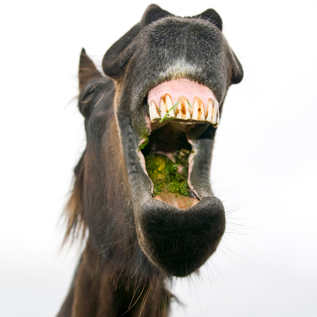
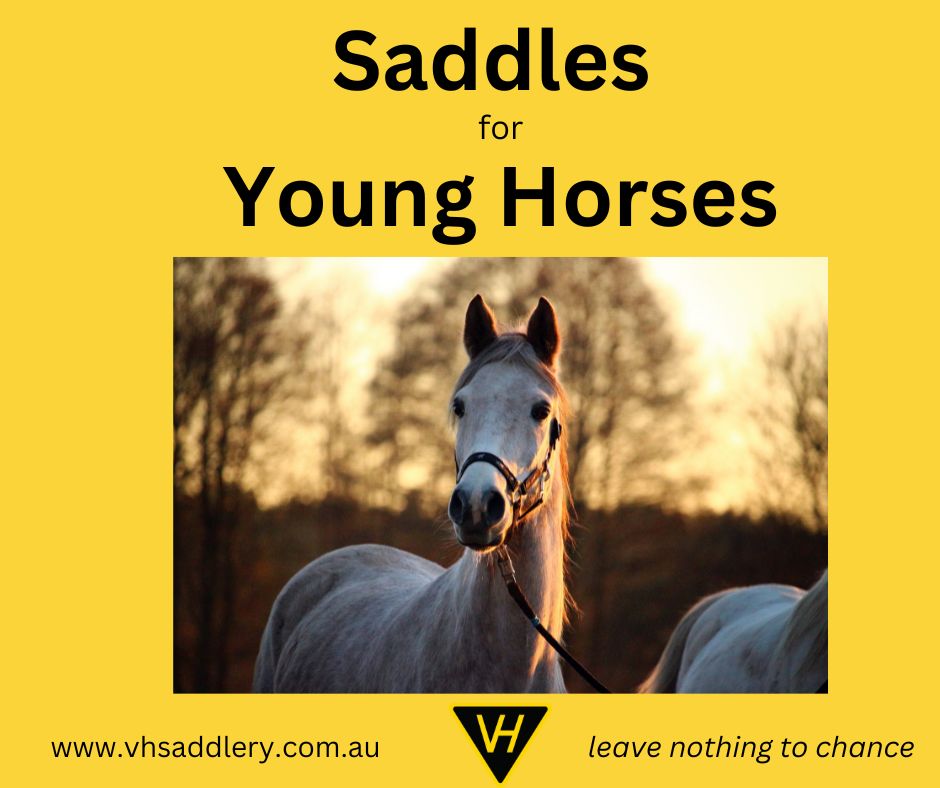
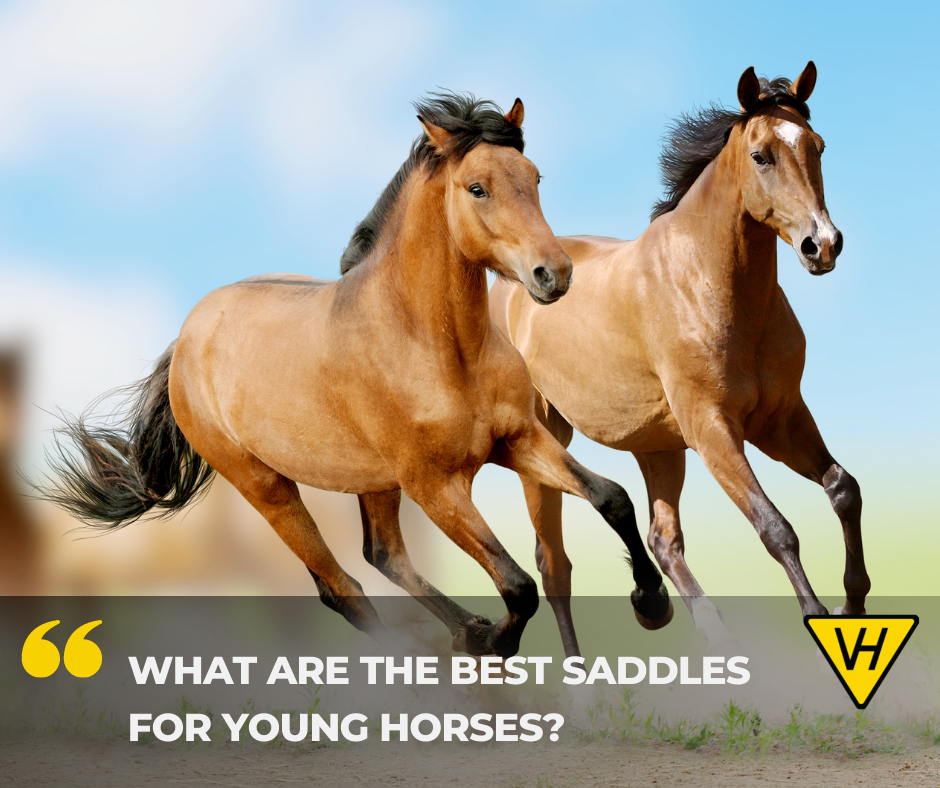



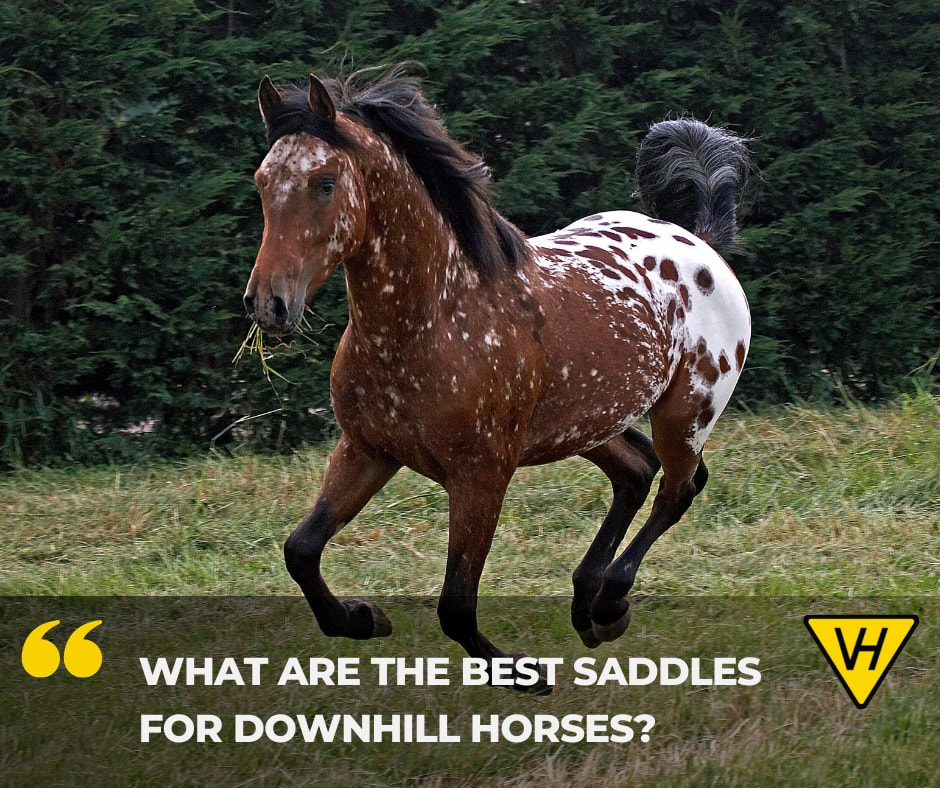
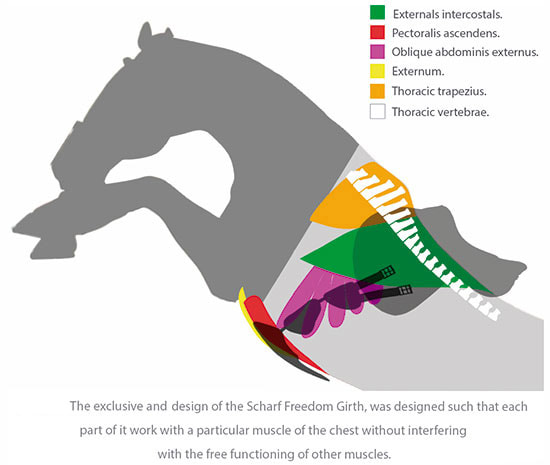
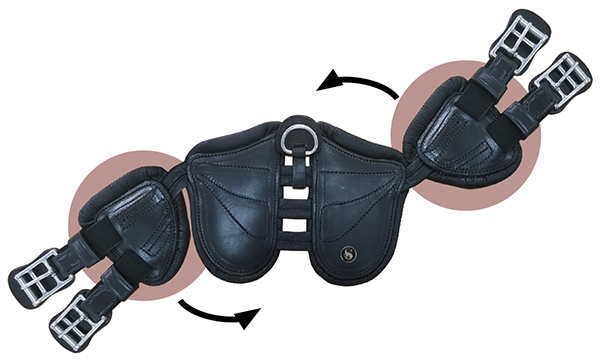
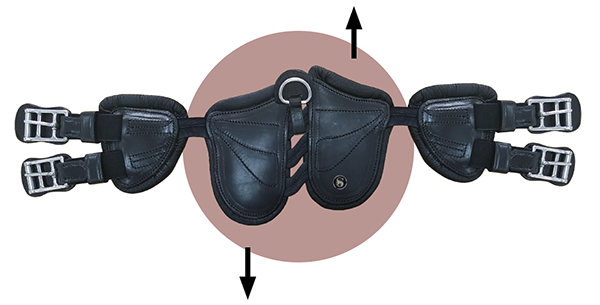
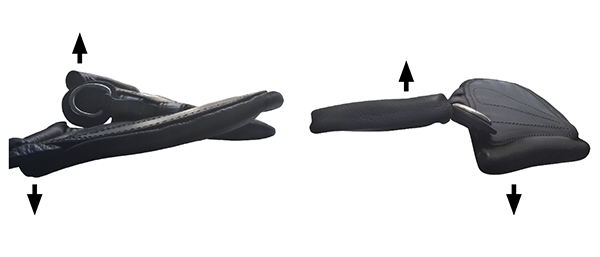
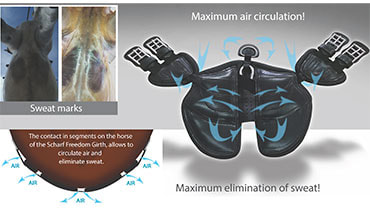
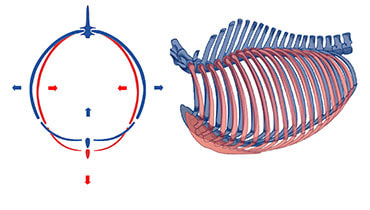
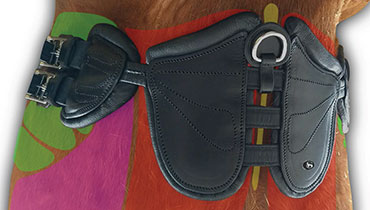

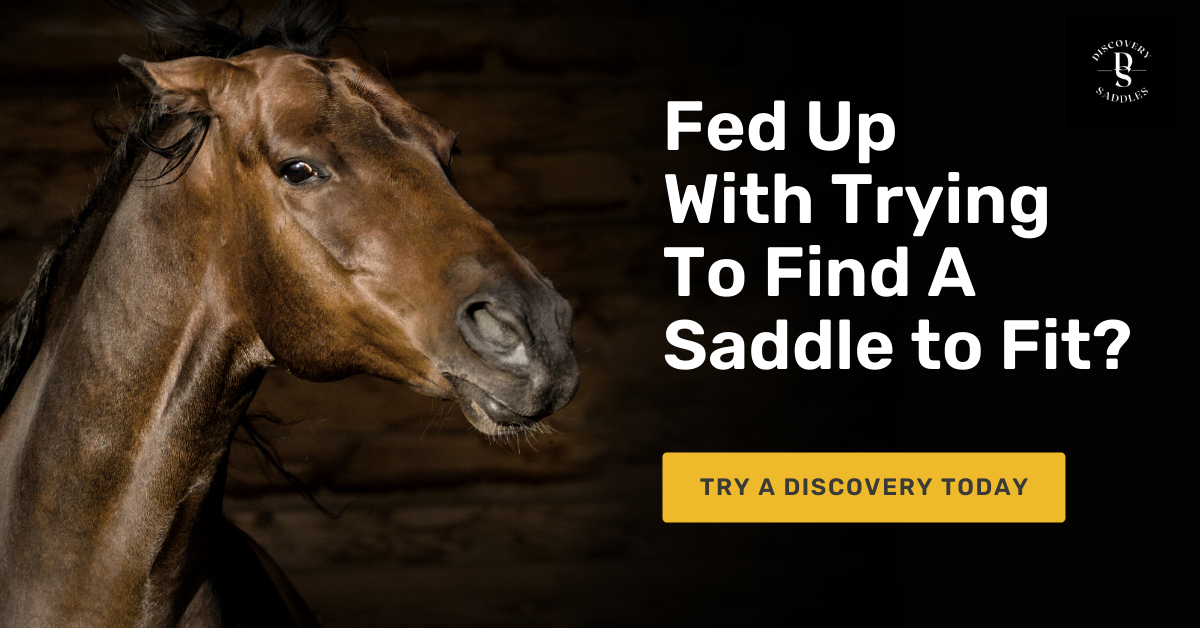
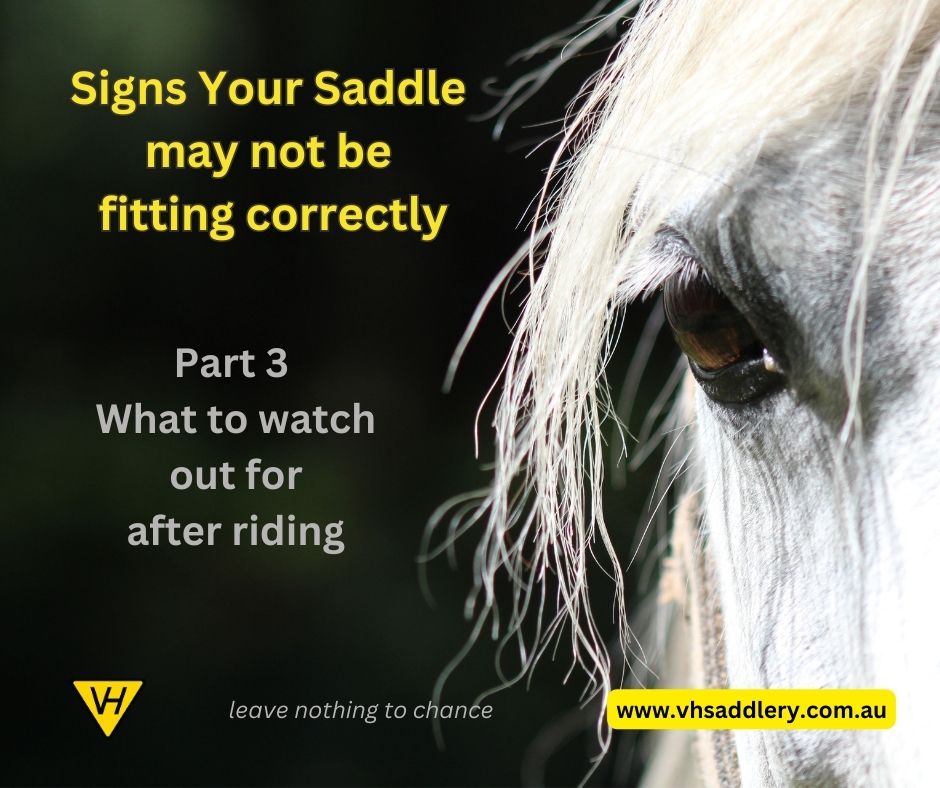
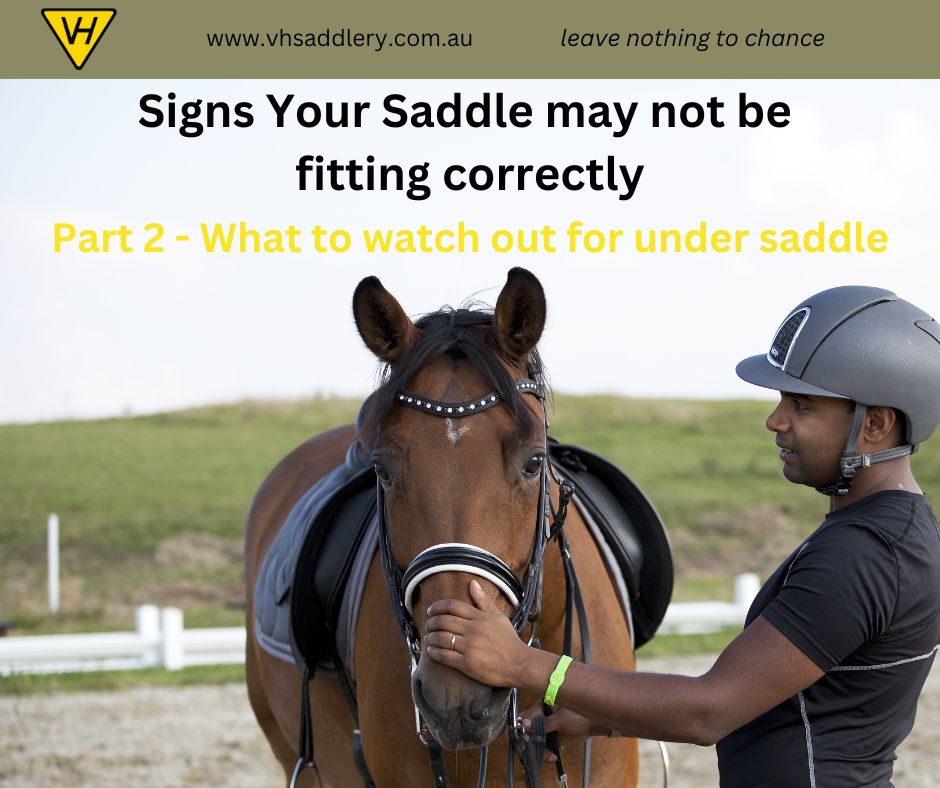

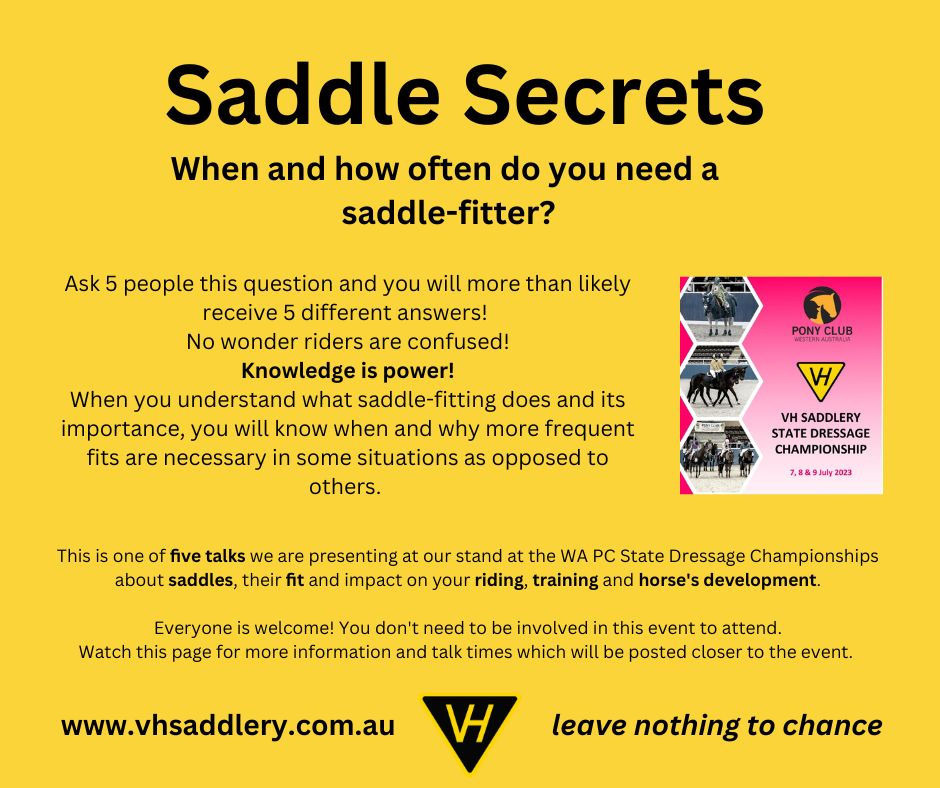
 RSS Feed
RSS Feed